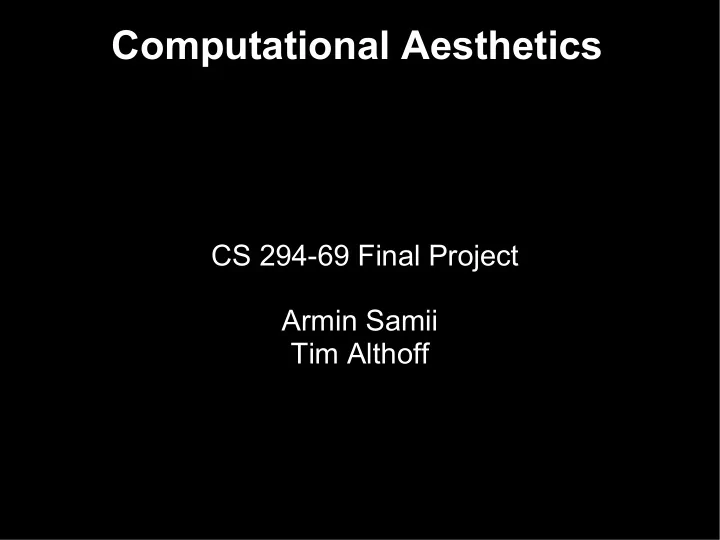

Computational Aesthetics CS 294-69 Final Project Armin Samii Tim Althoff
Problem
Problem
Problem
Problem Some change Original Some change Result
Problem Exposure +2 Original Some change Result
Problem Exposure +2 Original Contrast +20% Result
Problem Exposure +2 Original Contrast +20% Saturation +25%
Roadblocks Training Data Sequence Learning Noisy Feature-dependence Repetitions (avoid repeating same sequence) Training a good model Hard to obtain Parameter Learning User Interface Predict parameters Simplicity using regression Facilitate learning
Approach Feature Extraction Must be done for each iteration
Approach Feature Extraction Must be done for each iteration Must be fast
Approach Feature Extraction Must be done for each iteration Must be fast We work on small (100x100) images
Approach Feature Extraction Must be done for each iteration Must be fast We work on small (100x100) images Features must be simple enough to be detected in thumbnails
Approach Feature Extraction Must be done for each iteration Must be fast We work on small (100x100) images Features must be simple enough to be detected in thumbnails Features we use Color-based
Approach Feature Extraction Must be done for each iteration Must be fast We work on small (100x100) images Features must be simple enough to be detected in thumbnails Features we use Color-based (e.g. histograms, contrast, etc.)
Approach Feature Extraction Must be done for each iteration Must be fast We work on small (100x100) images Features must be simple enough to be detected in thumbnails Features we use Color-based (e.g. histograms, contrast, etc.) Simple Haar features for face detection
Approach Feature Extraction Must be done for each iteration Must be fast We work on small (100x100) images Features must be simple enough to be detected in thumbnails Features we use Color-based (e.g. histograms, contrast, etc.) Simple Haar features for face detection (distinguish between portraits, group shots, etc.)
Approach Feature Extraction Must be done for each iteration Must be fast We work on small (100x100) images Features must be simple enough to be detected in thumbnails Features we use (~30 total) Color-based (e.g. histograms, contrast, etc.) Simple Haar features for face detection (distinguish between portraits, group shots, etc.)
Approach Parameter learning Sequence Learning P(adjustment strength | P(next adjustment(s) | features, adjustment) features, previous adjustments) Regression techniques N-grams + features Adjustment ? Exposure Parameter ?
Approach Parameter learning Sequence Learning P(adjustment strength | P(next adjustment(s) | features, adjustment) features, previous adjustments) Regression techniques N-grams + features Contrast Exposure -15%
Approach Parameter learning P(adjustment strength | features, adjustment) Regression techniques: Linear Ridge Lasso Lars ElasticNet Gaussian Procress
Approach Sequence Learning P(next adjustment(s) | features, previous adjustments) → ”Feature-augmented n-grams” n-gram: sequence of n items from a given sequence n-gram model → (n − 1)-order Markov model Feature augmentation Modelled by GMM Tri-gram
Approach User interface Show user each step in sequence
Results: Parameter learning
Results: Sequence learning
Future Work More features Local edits Treat skin separately Gradients (e.g. horizon) Foreground/background separation Style modeling User personalization a*GeneralModel + (1-a)*UserModel User study
Recommend
More recommend